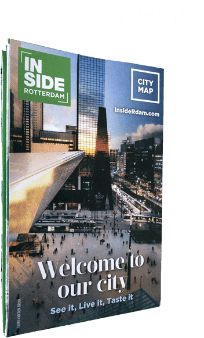Powerhouse Company is an award-winning architecture office based in Rotterdam. Known for some striking buildings and initiatives in the city. But the firm also designs on a smaller scale. Together with Lensvelt the Coquille Chair was developed. A new indoor-outdoor sustainable chair.
The launch has taken place at the Floating Office Rotterdam. Headquarters of Powerhouse Company and one of the striking projects of Powerhouse Company in Rotterdam. Recently they unveiled a masterplan for the site of the Codrico factory at the Rijnhaven and a new rising landmark next to Hofplein.
The new chair can be considered a homage to one of nature’s most amazing designs. It’s technically audacious and handcrafted in Italy, Coquille is also 100 percent recyclable. On a symbolic level, the design by Nanne De Ru and Maarten Diederix, designer at Powerhouse Company, was inspired by one of the best-loved paintings of the Italian Renaissance. Sandro Botticelli’s Birth of Venus.
The Coquille Chair evokes hopeful new beginnings
The scallop is both a delicious delicacy and a popular design motif. Used since prehistoric times as ornaments, jewelry and sometimes even money, seashells have a long history as elements in architecture and design. Scallop shells are also a symbol of pilgrimage and life’s journey: the story starts, like Venus’ tale, when the shell touches the shore. Our chair evokes this feeling of arrival and hopeful new beginnings.
The original model for Coquille was the classic modernist bent wood and rattan bistro chair. The Lensvelt furniture company, was mindful of the pandemic and wanted a chair that could be used outdoors as well as inside. This preference for versatility suggested tubular steel – a material loved by modernists since Marcel Breuer. Of course, the shiny reflective metal also echoes the fluid quality of water.

Using steel, a design that is a total object was sculptured. The generous back with its elegantly curving ribs sits atop a swivel base that rests on four legs, each with a boldly curving profile. There were many technical challenges in developing the design, which were solved with great ingenuity by Lensvelt R&D and the skilled artisans of the Italian manufacturers. Not least the extreme degree of bending needed for the uniquely shaped legs. Requiring holes to be punched in them, which were later refilled. Getting the legs right was the key to the design. Visually they extend the flowing form of the chair body into a single, infinitely flowing line. The upholstered seat then sits in the center of the chair, like a pearl in an oyster.
Every architect wants to design a chair
With a fine collection of architects’ chairs at the office, it was inevitable that Powerhouse Company would produce its own one day. After all, every architect wants to design a chair. Because a chair can so perfectly distill the essence of an architect’s style. A chair brings work to a wider public, and it creates a uniquely intimate relationship with those who use it.
The Coquille Chair, like the buildings by Powerhouse Company, is classical yet innovative. It sculpts space using a modernist vocabulary of proportion, scale, and geometry, which it adapts in a fresh and contemporary way. It’s a perfect fusion of form and function, and it has a powerful presence. It is simply elegant. More than just a chair, it’s a kind of microcosm of a Powerhouse Company building.
‘The base is technically very difficult – yet it makes the design so strong and unforgettable, like a precious object,” says Hans Lensvelt, the CEO of participating Lensvelt. This Furniture Design Label wants to give architects and interior designers the right tools to create next-level interiors. In 2021, Lensvelt received the Dezeen Design Award for Most Sustainable Design for example. Blink, is an airport seating system design by Rotterdam-based Richard Hutten. The seats were produced by recycling old and used furniture from Schiphol Airport.
Coverphoto: Casper Rila / 500WATT















